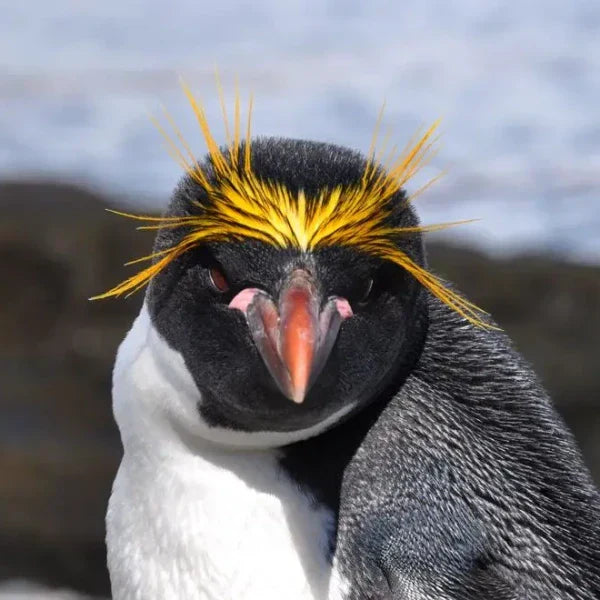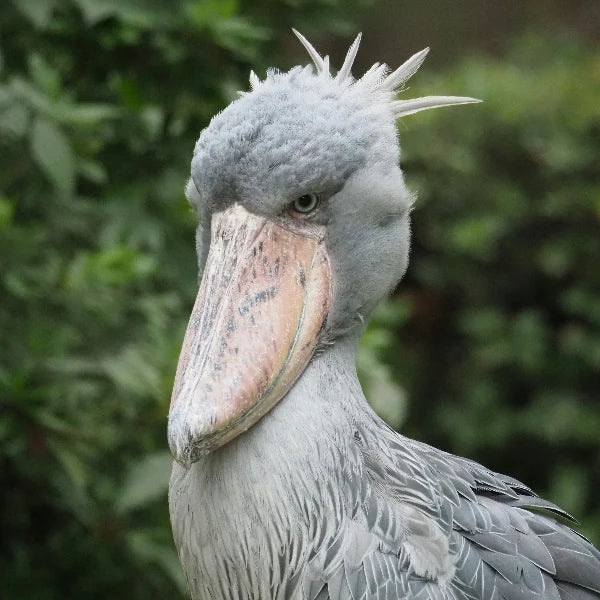Quick quiz: What has a tuxedo-style body, can't fly, and sports an unforgettable golden-yellow hairstyle? If you answered the macaroni penguin, you're right! These cute birds have been in the spotlight recently.
Their unique appearance and their playful personalities have captured the hearts of wildlife enthusiasts around the globe. But why is this bird so special? Is it just their fancy hairdo, or is there something more beneath those flashy feathers?
In this article, we will explore everything from their bizarre name to their everyday habits, home, unusual mating rituals, and conservation problems they are currently experiencing.

Why “Macaroni”?
First things first: Why in the world is this penguin called "Macaroni"? The name may remind you of tasty pasta, but it actually has 18th-century English origins. In England at that time, men who dressed up in flashy attire with feather hats and flamboyant clothes were called "Macaronis".
The yellow crest of these penguins reminded British sailors of those fashion men. It was these sailors who started referring to the birds as macaroni penguins, and the nickname stuck.
Source: Animal Fact Files | YouTube
Physical Characteristics
Macaroni penguins are best known for their dashing appearance. An adult macaroni Penguin stands approximately 70 cm tall and weighs 4 to 7 kilograms. Their most striking feature is the bright yellow crest on their heads.
They are often called the "rock stars" of the penguin world, and they deserve it. Their most defining feature is the yellow feathers, making them part of the crested penguin family.

Source: https://southafrica.angloamerican.com/our-stories/from-mhluzi-to-marion-island-dineo-makes-her-mark
Adaptations
However, other than their unique feathers, macaroni penguins have a lot in common with other penguins. Like all penguins, macaroni penguins are flightless birds; that is, they cannot fly across the skies like most birds.
But unlike most flightless birds, who are awkward on water, macaroni penguins are great swimmers. They are able to dive to gigantic depths of 70 meters to 100 meters in some cases. Like other penguins, macaroni penguins are suited to live in cold climates.
Their feathers are close and watertight, preventing water and cold from seeping into their bodies. Beneath their streamlined bodies, macaroni penguins also have a fat layer to provide insulation against freezing temperatures.
Macaroni penguins also have a personality that matches their unique look. They have a way of connecting that's nearly human-like by being playful and inquisitive.
If you’re fascinated by birds with unique adaptations, you might also enjoy learning about the Shoebill Stork — an ancient-looking bird with a powerful stare and dinosaur-like features — or the Potoo, the master of camouflage in the night forests of South America.

Source: https://www.pinterest.com/pin/300896818874432200/
Life in the Wild: Habitat and Habits
Macaroni penguins are native to the Antarctic and sub-Antarctic, where they live on several isolated islands. Their habitat consists mainly of islands in the Southern Ocean, including the Falkland Islands, South Georgia, and the South Sandwich Islands.
The islands provide macaroni penguins with perfect habitat. This environment offers the cold climate in which they like to reside. Their colonies are typically found on rocky shores, where they breed and nest safely in vast numbers.
Their colonies can be enormous at times, numbering in hundreds of thousands. This number makes macaroni penguins one of the most highly concentrated penguin species. These birds, however, do not stay on land for very long. They spend their entire lives swimming through cold, harsh ocean currents; talk about endurance!
Diet and Feeding Behavior
Macaroni penguins are opportunistic feeders, eating whatever prey is most abundant. They feed on small fish, krill, and squid. Prey are plentiful in the rich waters surrounding their colonies. The penguins have good swimming skills, utilizing their strong flippers to move through the water with great ease. They can dive as deep as 70 meters to forage for food.
While the macaroni penguin is a good predator itself, it also has predators. In the water, the two biggest threats are seals and orcas. On land, skuas and other seabirds are the biggest threat, and they feed on their eggs and chicks.
However, the macaroni penguins are very protective of their nests. The vast colonies that they inhabit do offer some protection against them.

Source: https://www.pinterest.com/pin/239605642665209901/
Behavior and Social Structure
Macaroni Penguins are famous for their sophisticated courtship displays. During the breeding season, males show off their colorful crests, vocalize loudly, and dance-like presentations. All this elaborate performance is a way for the male penguins to win over the females.
Once paired, macaroni penguins often bond for life. They return annually to the same nesting site, a romance most fairy tale love stories can’t top. Both the male and female macaroni penguin penguins are responsible for raising their young.
The female lays two eggs, but only the second larger egg hatches and is raised. The two parents take turns sitting on the eggs. One of the parents sits on the egg while the other goes out to seek food. This division of labor ensures that the chick is always well taken care of.
Egg incubation can be tricky because the environment is cold. To keep the eggs warm, Penguins store them in a special brood pouch in their belly.

Environmental Threats
Despite their rugged and endearing characteristics, macaroni penguins face a host of issues that threaten their survival. Global warming, fishing, and human activities all endanger these birds and their fragile homes. This issue is a stark reminder that no one is spared from the harsh realities of our world.
Global warming dramatically affects macaroni penguins. Increasing sea temperatures and altered weather patterns affect the abundance of their favorite foods. When food is limited, these penguins have to use additional energy to find food.
Increased foraging behavior when food is scarce can result in reduced reproductive success. After foraging, the parents return exhausted from taking care of their chicks or incubating eggs properly.
Overfishing is also a problem. The Southern Ocean, where they live, has traditionally been famous for its abundant sea life. Commercial fishing, however, has decreased the amount of food available to the penguins. This reduction is concerning because penguins need a constant supply of food to eat and fatten up their chicks.
Human activity, both direct and indirect, continues to threaten penguins. Their habitat is also becoming more polluted with oil spills, plastic debris, and chemicals. Penguins are known to confuse plastic for food, so they ingest it, which can harm them. Additionally, oil spills soil penguin feathers, preventing them from swimming or regulating their body temperatures.

Source: https://www.pinterest.com/pin/964333338960526379/
Conservation Status
Conservation efforts are in top gear, thanks to the efforts of dedicated researchers and agencies worldwide. Many organizations are involved in monitoring penguin populations and conserving their critical habitats. International organizations such as the International Union for Conservation of Nature (IUCN) monitor species like the Macaroni penguin.
Monitoring protocols are set in place to estimate their extinction threat and channel conservation efforts. These efforts ensure that future generations can enjoy the sight of these exceptional birds in their natural habitats.
Final Thought
Macaroni Penguins are more than cute birds with weird hairdos; they're an essential barometer of ocean health. By preserving these animals, we are maintaining balance in one of Earth’s most fragile habitats. By supporting conservation, reducing our carbon footprint, and educating people, we can ensure these birds can continue to thrive for years to come.

Source: https://www.pinterest.com/pin/435371489303524299/
FAQs
1. Can Macaroni Penguins Fly?
No, like all penguins, macaroni penguins can't fly. They adapted their wings into flippers, which makes them excellent swimmers.
2. Why is the Yellow Crest So Vital?
The yellow crest is not merely cosmetic; it plays a role in social encounters and courtship rituals. This visual cue enables potential mates to size each other up during the breeding season.
3. Where Can You See Macaroni Penguins in the Wild?
Their homelands are split between sub-Antarctic islands and most of the Southern Ocean. They live in isolated, rocky regions with abundant food and few predators. The habitats look harsh but are ideal for the penguin’s unique way of life.
4. How Do Macaroni Penguins Mate?
Macaroni penguins are monogamous. Males acquire females with showy courtship displays, such as puffed chests, calling, and showing off their bright yellow crests. After they mate, both parents take turns incubating eggs and raising chicks.
5. How Long Do Macaroni Penguins Live?
In the wild, they live for an average of 10–20 years. However, this average is decreasing drastically as many penguins are subject to threats that shorten their lifespan.
6. How Are Macaroni Penguins Adapted to Their Habitat?
They have distinctive physical and behavioral traits that help them survive through harsh weather and a meager diet. From their streamlined swimming capacities to their cuddled social congregations, their entire existence is a survival textbook. Their resiliency is something to wonder at, either by scientists or nature lovers.
7. How Can We Help Macaroni Penguins?
A simple way to give back is to Support conservation organizations. Two of the most prominent organizations are Penguin Conservation International (PCI) and BirdLife International. Their primary objectives involve conserving penguins through research, campaigns, and awareness.



2 comments
PeckPerk
Right? This little rockstar in a tux is more than just cute—it’s a reminder of how important ocean conservation is. Our sea creatures, like the macaroni penguin, need clean, thriving oceans to survive. Thanks for speaking up for them! 🐧💛🌊
Ben
Look at this beautiful bird, our sea creatures do need to be properly taken care of
Leave a comment
All comments are moderated before being published.
This site is protected by hCaptcha and the hCaptcha Privacy Policy and Terms of Service apply.